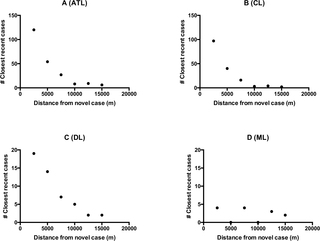PLOS Neglected Tropical Diseases ( IF 3.4 ) Pub Date : 2017-11-02 , DOI: 10.1371/journal.pntd.0006015 Juliana Silva , Adriano Queiroz , Izabella Moura , Rosana S. Sousa , Luiz Henrique Guimarães , Paulo Roberto Lima Machado , Marcus Lessa , Ednaldo Lago , Mary E. Wilson , Albert Schriefer

|
Background
American Tegumentary Leishmaniasis (ATL) caused by Leishmania braziliensis is endemic in Corte de Pedra, Northeast Brazil. Most L. braziliensis infections manifest as localized cutaneous leishmaniasis (CL). Disseminated manifestations include mucosal leishmaniasis (ML), present at a low constant level for several decades, and newly emerging disseminated leishmaniasis (DL). Surprisingly, DL has recently surpassed ML in its spatial distribution. This led us to hypothesize that distinct forms of ATL might spread in different patterns through affected regions.
Methodology/Principal findings
We explored the incidence and geographic dispersion of the three clinical types of ATL over a span of nearly two decades in Corte de Pedra. We obtained the geographic coordinates of the homes of patients with ATL during 1992–1996, 1999–2003 and 2008–2011. The progressive dispersion of ML or DL in each time period was compared to that of CL in 2008–2011 with the Cusick and Edward’s geostatistical test. To evaluate whether ATL occurred as clusters, we compared each new case in 2008–2011 with the frequency of and distance from cases in the previous 3 to 12 months. The study revealed that DL, ML and CL actively spread within that region, but in distinct patterns. Whereas CL and DL propagated in clusters, ML occurred as sporadic cases. DL had a wider distribution than ML until 2003, but by 2011 both forms were distributed equally in Corte de Pedra. The incidence of ML fluctuated over time at a rate that was distinct from those of CL and DL.
Conclusions/Significance
These findings suggest that CL and DL maintain endemic levels through successive outbreaks of cases. The sporadic pattern of ML cases may reflect the long and variable latency before infected patients develop clinically detectable mucosal involvement. Intimate knowledge of the geographic distribution of leishmaniasis and how it propagates within foci of active transmission may guide approaches to disease control.
中文翻译:

巴西东北部利什曼原虫(Viannia)braziliensis感染的高度流行地区的美国四肢利什曼病的动态
背景
巴西利什曼原虫引起的美国地膜利什曼病(ATL)在巴西东北部的Corte de Pedra流行。大多数大号。巴西感染表现为局部皮肤利什曼病(CL)。弥散性表现包括粘膜利什曼病(ML)(持续几十年处于较低的恒定水平)和新近出现的弥散性利什曼病(DL)。令人惊讶的是,DL最近在空间分布上已超过ML。这使我们假设,不同形式的ATL可能会以不同的方式传播到受影响的地区。
方法/主要发现
我们研究了近二十年来在Corte de Pedra三种ATL临床类型的发生率和地理分布。我们获得了1992-1996年,1999-2003年和2008-2011年ATL患者房屋的地理坐标。通过Cusick和Edward的地统计学检验,将每个时间段ML或DL的逐步分散与2008-2011年CL的逐步分散进行了比较。为了评估ATL是否以集群形式出现,我们将2008-2011年的每个新病例与前3到12个月中病例的发生频率和距离进行了比较。研究表明,DL,ML和CL活跃地在该区域内传播,但模式不同。而CL和DL在集群中传播,而ML则是偶发的情况。直到2003年,DL的分布都比ML广,但到2011年,两种形式在Corte de Pedra的分布均等。
结论/意义
这些发现表明,CL和DL通过连续的病例暴发维持流行水平。ML病例的零星模式可能反映了感染患者发展出临床上可检测到的粘膜受累之前的漫长而可变的潜伏期。对利什曼病的地理分布及其如何在主动传播的病灶内传播的深入了解可以指导疾病控制方法。










































 京公网安备 11010802027423号
京公网安备 11010802027423号